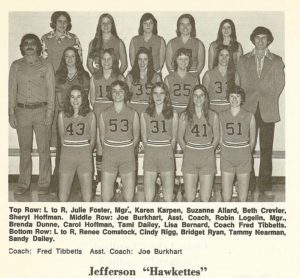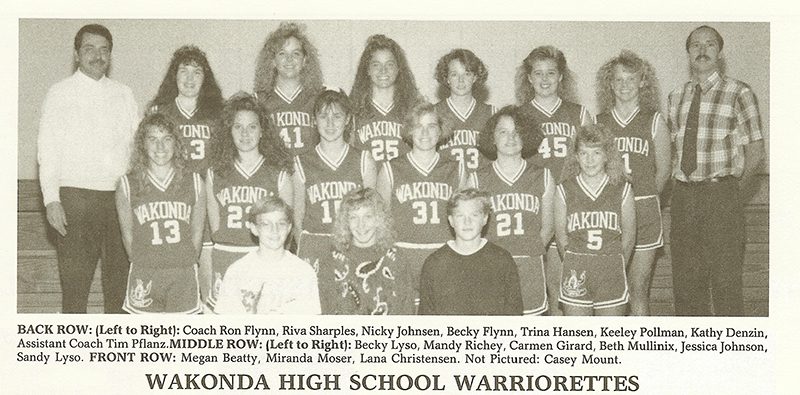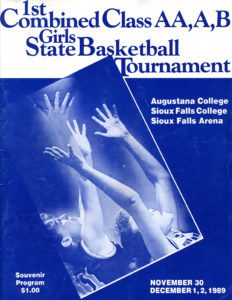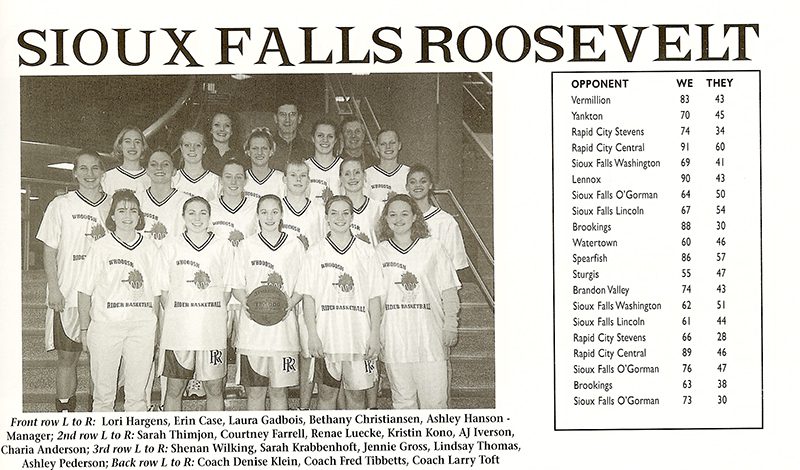Girls High School Basketball Records
GIRLS BASKETBALL
by Rob Van Laecken, Ruth Rehn, and David Kemp
Girls playing basketball as part of the athletic activities of South Dakota schools began in the first years of the twentieth century. The athletic activities that concluded the 1907 school year, and which included the second annual boy’s state track meet, included an informal girl’s basketball tournament. This event was held at the University of South Dakota in Vermillion. Basketball was invented by James Naismith in 1891. Women’s competition began in March of 1892. The early development of girl’s basketball parallels the early development of boy’s basketball in the high schools. Several restrictions were placed on the women’s girls due to the belief that strenuous athletic activities by teenage girls would cause permanent physical damage. There were organized teams and state girl’s basketball tournaments held in South Dakota during the 1924,1925, and 1926 seasons. The 1924 and 1926 tournaments were hosted by Dakota Wesleyan College. The 1925 tournament was hosted by Lake Andes High School. At that time there was an effort to limit the activities of girls playing basketball throughout the state in response to activities by the Amateur Athletic Union at the national level in 1923. Many girls were restricted to participation in only intramural basketball competition; however, there were still girls and schools playing basketball from 1927 to 1975, including teams with varsity schedules, rosters, and hired coaches. At different occasions local conferences, with season ending tournaments were developed. There was no fully recognized state wide organization of teams. In 1974 the full court game was adopted statewide by the South Dakota high school teams. In 1975 girl’s basketball became a sanctioned high school sport in South Dakota.
The sanctioning of girl’s basketball was an immediate result of Congress passing the Title IX Law of 1972 requiring equal participation for girls and women in sports in our nation’s high schools and colleges. In the months after the implementation of Title IX, legal action began involving the Brookings High School Board. The advocates of the implementation of the Title IX legislation chose to work with the Brooking School Board. It was determined that the Brookings schools actually provided as many, or possibly more opportunities in sports than most schools in South Dakota. The outcome of the litigation was the determination that a school system such as Brookings, was doing a better job than most schools, but this was still not adequate under the guidelines established under Title IX. The litigation emphasized to develop and sanction more sports for girls at the high school level. Girl’s basketball was to be one of these sports.
At the May 25, 1974 meeting of the Activities Association the board of control considered an amendment to the Athletic by-laws of the Association which would delete Section 2 of Article III. Section 2, Article III read,
No Girls Basketball Tournaments. There shall be no girls’ basketball tournament sponsored by any member of this Association, and no member school shall permit a team from its school to participate in a girl’s tournament.
Executive Secretary Dave Evans stated that he had received a letter from Kermit Sande, the attorney general of South Dakota, which indicated that the regulation was probably unconstitutional.
Following a brief discussion of the board Leo Uken of Bridgewater moved that the group present go on record supporting the proposal of the Board of Control to have the regulation removed from the by-laws. The resolution passed unanimously on a voice vote. Laterly it passed by a vote of the member schools during the summer of 1974.
During the fall of 1974, it was established that the girls’ season be held during the fall to prevent conflicts with the boys’ programs over the usage of gym space. The first sanctioned season began on September 5, 1975 and the first state tournament was held December 3-5, 1975. The format of the tournament was the same as the existing boys’ tournaments.
Teams and players that were successful in winning basketball games in the first years came from programs that had established training in fundamentals and which had played a limited schedule which included teams from the surrounding states of Iowa, with the two court rules and six girl ‘Iowa Rule”, Nebraska, Wyoming and Minnesota. All states that had organized school teams in operation. Jefferson High School, which won the first Class B Championship in 1975, is an example of one of the early successful teams. The Jefferson High School won the 1975 Class “B” championship game over Northwestern Lutheran Academy of Mobridge, 65-33. Jefferson finished with a season record of 25-0. The Jefferson team compiled an overall record of 55-4 from 1972 through 1975. Their only loss to a South Dakota school was to Gayville-Volin during the 1971-1972 season. The 1975 Class “A” State Championship was won by Yankton High School (14-3) over Watertown High School (22-1).
Development of the first girl’s basketball programs encountered various difficulties. Several school districts hired coaches who did not have the basic knowledge and skills to coach basketball. Many districts felt that only women should coach girls, and at that time there were not a lot of women coaches available to coach girls basketball at the high school level. The coaches who remained in the coaching ranks for a number of years were those coaches, both women and men, who had basic knowledge and skills to teach girls basketball. There was great emphasis placed on developing the girls’ fundamental basketball skills, beginning at the early grade school levels at several South Dakota high schools. Women made up 43% of the girl’s basketball coaches in 1975. By 1989 the number was at 19.7%.
1975-1984:

Jefferson, 1975 State “B” Champions: Top row, L to R: mgr., Julie Foster; Karen Karpen, Suzanne Allard, Beth Crevier, Sheryl Hoffman; Middle row: Assistant coach, Joe Burkhart; mgr., Brenda Dunne; Carol Huffman, Tami Dailey, Lisa Bernard; Coach, Fred Tibbetts; Bottom row, L to R: Renee Comstock, Cindy Rigg, Bridget Ryan, Tammy Nearman, Sandy Dailey.
Jefferson dominanted the Class “B” division in the first years of girls basketball. Jefferson won the initial “B” championship in 1975, and consecutive championships from 1978 through 1980. Clear Lake won the 1976 Class “B” championship, defeating Jefferson 56-52 in the championship game. Clear Lake finished the season with a perfect 24-0 record.
Jefferson defeated Clear Lake for the 1979 Class “B” championship, 57-56, finishing the season with their fifty-five game winning streak intact. This game ended Clear Lake’s Robin Anderson’s four year career. She finished with a total of 2,332 career points, averaging 23.6 points per game. Robin’s career field goal percentage was 51%. Anderson established state tournament records of 82 points in the tournament, and 31 points in the championship game.
Yankton High School dominated the first years of the Class “A” division. The Gazelles won the first Class “A” championship in 1975, and consecutive championships from 1977 through 1979. Yankton was led by Diane Hiemstra, a three time, first team all state selection and Lisa Van Goor. Both Van Goor and Hiemstra were selected to the Parade “All American” team during their high school career. Yankton won the Class “A” champion in 1983.
During this period, it was common for outstanding Class “A” and Class “B” teams to schedule each other during the regular season. On November 7, 1980 defending Class “B” champion, Jefferson visited unbeaten, Sioux Falls Washington. The game at the Washington High School gym was standing room only. The contest came to signify the progress that had been attained in the first five years of sanctioned girl’s basketball. Jefferson was riding a sixty-seven game winning streak. Jefferson’ full court pressing defense was matched up against Washington’s aggressive scoring and rebounding capabilities. The final score was Washington 88, Jefferson 78. Washington out rebounded Jefferson fifty-three to twenty-five. JoElle Byre led Washington with forty points and eighteen rebounds. Washington shot fifty-seven percent for the game. Jefferson was even better with fifty-eight percent. The level of play was outstanding.
Jefferson won the 1980 Class “B” championship, 36-10 over Highmore. Sioux Falls Washington defeated Canton 52-45 for the Class “A” championship. Washington won forty-six games in a row winning the Class “A” championship in 1980 and 1981. The Warriors recorded a fifty game winning streak from 1980 into 1982.
Armour won the last two Class “B” state championships, 1983, and 1984 under the two class system. They went on to win the first three Class “B” state championships under the three class system.
Brookings won the last Class “A” state championship in1984 under the two class system, and won the first 1985 Class “AA” state championship under the three class system. They were 48-0 during their successive undefeated seasons, and won forty-nine consecutive games. Brookings was led by Renae Sallquist and Amy Mickelson; both received National H.S. “Prep All-American Girls Athletes” honors during their high school careers. The 1984 Brookings team finished in the “USA National Top Twenty” Poll at #6. The 1985 team finished in “USA National Top Twenty” Poll at #3. Brookings coach, Jim Hollwerda was selected as the USA National Coach of the Year in 1985.
1985-1994:
The second decade of sanctioned South Dakota girls’s basketball had many outstanding performers, both by individual performers and outstanding teams. The depth and quality of the players and team performances was remarkable. The tradition of South Dakota players going on to Division I college programs was established. More importantly, most South Dakota college programs were made up and featured South Dakota high school players.
In 1985, Lori Wohlleber of Summit established a new all time, career scoring record with 2,490 career points.
Yankton finished second to Brookings in 1985, at the first Class “AA” state championship. Yankton won the Class “AA” championship the next three years, 1986,1987, 1988.
Mitchell won Class “AA’ championships in 1990, 1992, and 1994. Mitchell won forty-five consecutive games during 1992 and 1993.
In Class “B” basketball Armour continued their run of five consecutive championships through 1987 with a championship game victory over Wakonda. Armour won forty-seven consecutive games during 1986 and 1987. Dana Nielsen of Armour scored 2,310 career points.

Wakonda, 1990 Class “B” Champions: Back row: Coach, Ron Flynn; Riva Sharples, Nicky Johnsen, Becky Flynn, Trina Hansen, Keeley Pollman, Kathy Denzin; Assistant coach, Tim Pflanz; Middle row: Becky Lyso, Mandy Richey, Carmen Girard, Beth Mullinix, Jessica Johnson, Sandy Lyso; Front row: Megan Beatty, Miranda Moser, Lana Christensen; team member, Casey Mount.
Wakonda would win the Class “B” championship the next three years, 1988 through 1990. Wakonda won one hundred and one consecutive games from 1998 into 1991. Becky Flynn of Wakonda scored 3,268 points during her high school career, the all time point total in South Dakota basketball history.
Carla Allard of Bennett County completed her high school career in 1987. She established the all time scoring record with 2,835 career points.

Program Cover, 1989 Combined State Tournament
After four years of preperations all three of the 1989 girl’s state basketball tournaments were held on the same weekend in the same city, Sioux Falls. The tournaments were held at three locations in Sioux Falls. All three finals were held on Saturday at the Sioux Falls Arena.
SuAnne Big Crow of Pine Ridge led the Thorpes to the 1989 Class “A” state championship. Big Crow scored sixty-seven points in a single game and 761 points overall during the 1989 season. SuAnne scored 2,541 points during her high school career. SuAnne scored 743 points during the 1991 season, including a single game total of fifty-four.
Amy Burnett was a three time, Class “AA” all state selection, 1988-1990, finishing with 1,963 career points.
Northwestern won the 1991 Class “B” state championship, while winning forty-seven consecutive games.
In the Class “A” ranks Miller registered a seventy-three game winning streak from 1991 into 1993. Miller finished runner-up in 1991 and won consecutive Class “A” titles in 1992 and 1993.
1995-2005:
The most significant change during this time period was the change of seasons. In response to litigation the Activities Assocation voted to change girl’s basketball from the fall to the winter season. The 2001 season was played in the fall. The next season began in December of 2002 and ended with the state tournaments in March of 2003.

Sioux Falls Roosevelt, 2000 State Class “AA” Champions: Front row, L to R: Lori Hargens, Erin Case, Laura Gadbois, Bethany Christensen; mgr. Ashley Hanson; Second row, L to R: Sarah Thimjon, Courtney Farrell, Renae Lueke, Kristin Kono, A. J. Iverson, Charia Anderson; Third row, L to R: Shenan Wilking, Sarah Krabbenhoft, Jennie Gross, Lindsay Thomas, Ashley Pederson; Back row: Coach, Denise Klein; Coach, Fred Tibbetts; Coach, Larry Toft.
Sioux Falls Roosevelt dominated the Class “AA” ranks during this period winning consecutive championships from 1997 through 2001. They set an all time record for consecutive wins from 1997 into 2002. Roosevelt won one hundred and seven consecutive games during the fall season, and an additional four games during a winter, national tournament. Fred Tibbetts, who coached at Jefferson in the 1975-1984 era, was the Roosevelt coach during the consecutive state championships and winning streak.
In Class “B” basketball, Baltic won state championships in 1995, 1996, 1998, 2001, and 2003. Waverly-South Shore won the 2000 Class “B” state championship, winning forty-seven consecutive games from 1999 into 2001.
Wagner was runner-up in the 1996 Class “A” state championship, and then went on to win the 1997 and 1998 Class “A” state championships. Mandy Koupal of Wagner scored 2,065 total points during her high school career. Koupal had a career field goal percentage of 69.1 percentage (758/1097). The 69.1 percent average is an all time national record for field goal percentage in a career. Her season field goal percentages 76.4 (223/292) in 1998, and her percentage of 75.3 (223/296) in 1997 are one and two on the all time national record list for field goal percentage in a season.
In 1996, Baltic established the national record for team field goal percentage in a season, shooting 56.5 percent; 691 for 1,222. This is the all time, national record for team field goal percentage in a season. In 1997, Wagner shot 54.7 percent; 639 for 1,168 which is second on the all time, national list.
From 2000 through 2003, Jenny Bridge of Hanson made 266 of 535 three point goals, a percentage of 49.7. This total is an all time, national record for three point goal percentage in a season. Bridge averaged 51.4 percent in 2002, and 50.4 percent in 2003.
ENDNOTES
Alternate Possession Rule
South Dakota was one of the first states to experiment with the alternate possession rule after a jump ball. The rule had been implemented at the college level and was tried on an experimental level during the 1982 girl’s season. The rule called for each team to receive possession of the ball on an alternating basis after each jump ball was called. The rule change was approved by the National Association for the 1983 season and continues in effect at the present time.
The Smaller Basketball
South Dakota was the first high school association to experiment with and utilize a smaller basketballs for girl’s play. The intermediate sized basketball are 28.5 to 29 inches in circumference. Experimental use of the intermediate basketball in the Rapid City Schools showed that the smaller ball increased the girls’ shooting range and reduced the game time by twenty minutes due to the reduced number of turnovers.
At the January 21, 1983, Activities Association meeting, the board of control voted unanimously to require the mandatory use of the intermediate basketball for all intrastate girls basketball games played during the 1983 regular season, sub-state tournaments and state tournaments.
Thirty Second Clock:
In May of 1982, girl’s basketball teams were given the option of implementing a thirty-second limit and shot clock. During the 1982 season twenty-two games were played utilizing the thirty second clock. Fifteen games were played at college gyms where the clocks were installed. Seven games were played using a stop watch. The teams were not required to purchase a shot clock. Schools found it difficult to pay and find officials to run the shot clock. At the end of the 1982 season sixty-six of eight-five schools voted to recommend that the shot clock experiment not be continued. The schools chose not to implement the shot clock limit.
Playoff System Changes
Challenge Game System:
The challenge game system was implemented in the early 1980’s. The challenge game system applied only in district tournaments, where the district champion and a second team advance to the regional tournament. It allowed the third place team in the district to challenge the district runner-up for the second qualifying spot, if the two teams had not played each other previously in the tournament. The system was designed to adjust to seeding “flukes” and to give every team more opportunity to play. The challenge system was eliminated after the 1988 season by a vote of the board of control.
Three Class System:
1985- : Beginning with the 1985 season high schools were divided into three classifications. Class “AA” consisted of the sixteen schools with the largest average daily membership (ADM) in grades 9-12. “A” classification consisted of the next sixty-four, largest high schools. The remaining high schools were placed in the “B” classification.
As a result of the move to three classes, the Class “AA” and Class “B” state tournaments were scheduled for the same weekend. This was the first time in South Dakota basketball history that two state basketball tournaments were scheduled on the same weekend.
Beginning with the 2003-04 school year the SDHSAA membership, through an amendment to the Constitution and Bylaws, changed the classification formula to the ADM of students in grades 9-11 versus students in grades 9-12 when determining classification. Beginning with the 2005-2006 school year, the classification system was revised again. Class “AA” was to consist of schools with an average daily membership (ADM) of 450 and above, Class “A” to consist of schools with an ADM of 449.999 to 90 and Class “B” to consist of schools with an ADM of 89.999 and below.
The “AA” field consisted of four districts made up of four teams. The first place team in each district tournament qualified for the state tournament. The runner-up and third place team in each district qualified for an additional regional championship. The runner-up of one region played the third place team of another region. Sites for the region championship contests are determined by each region on a yearly basis. The two west regions started a rotation where the region championship game in one gender was played east of the river and the championship game of the opposite gender was played west of the river, regardless of which team was the higher seeded team. The two east regions have always had the top seeded team host the region championship game in both genders. These winners played for the region championship and a place in the state “AA” tournament. The “AA” tournament is an eight team affair. The initial region champions received the top four seeds in the state tournament based upon their overall season seed points. The remaining region champions were bracketed into the state tournament based on their seed points but did not play someone in the first round of the state tournament they had already played in the district tournament. Beginning with the 2005 state tournament, the “AA” state tournament was seeded 1 through 8 after all teams have qualified for the state tournament.
The class “A” tournament originally consisted of sixteen districts of four teams each. With more schools forming cooperatives, the number of teams in a district may vary with districts having either 3-4 or 5 teams per district. Two districts combine to form a total of eight regions with the two district champions playing for a regional championship with the region champion advancing to the State “A” tournament. Some schools are forming cooperatives in one gender and not the other which may cause the district makeup to vary from one gender to the other. The “A” tournament is a single elimination affair with the region champions seeded into the state tournament after all teams have qualified for the state tournament.
Girls Basketball by Rob Van Laecken, Ruth Rehn, David Kemp
